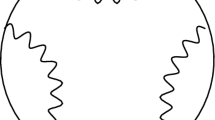Abstract
Using the algorithm of constructing the IR finite observables discussed in detail in our earlier papers, we study the construction of such observables in N = 8 supergravity in the first nontrivial order of perturbation theory. In general, contrary to the amplitudes defined in the presence of some IR regulator, such observables do not reveal any “simple” structure.
Similar content being viewed by others
References
L. J. Dixon, “Gluon Scattering in N = 4 Super-Yang-Mills Theory from Weak to Strong Coupling,” Proc. Sci. RADCOR2007, 056 (2007); arXiv: 0803.2475 [hep-th].
Z. Bern, L. Dixon, D. C. Dunbar, and D. A. Kosower, “Fusing Gauge Theory Tree Amplitudes into Loop Amplitudes,” Nucl. Phys. B 435, 59–101 (1995); arXiv: hep-ph/9409265.
Z. Bern, L. Dixon, D. C. Dunbar, and D. A. Kosower, “One-Loop n-Point Gauge Theory Amplitudes, Unitarity and Collinear Limits,” Nucl. Phys. B 425, 217–260 (1994); arXiv: hep-ph/9403226.
Z. Bern, M. Czakon, L. J. Dixon, D. A. Kosower, and V. A. Smirnov, “Four-Loop Planar Amplitude and Cusp Anomalous Dimension in Maximally Supersymmetric Yang-Mills Theory,” Phys. Rev. D 75, 085010 (2007); arXiv: hep-th/0610248.
F. Cachazo, M. Spradlin, and A. Volovich, “Four-Loop Cusp Anomalous Dimension from Obstructions,” Phys. Rev. D 75, 105011 (2007); arXiv: hep-th/0612309.
D. C. Dunbar and P. S. Norridge, “Infinities within Graviton Scattering Amplitudes,” Class. Quantum Grav. 14, 351–365 (1997); arXiv: hep-th/9512084.
Z. Bern, L. Dixon, M. Perelstein, and J. S. Rozowsky, “Multi-leg One-Loop Gravity Amplitudes from Gauge Theory,” Nucl. Phys. B 546, 423–479 (1999); arXiv: hep-th/9811140.
Z. Bern, L. Dixon, D. C. Dunbar, M. Perelstein, and J. S. Rozowsky, “On the Relationship between Yang-Mills Theory and Gravity and Its Implication for Ultraviolet Divergences,” Nucl. Phys. B 530, 401–456 (1998); arXiv: hep-th/9802162.
Z. Bern, J. J. Carrasco, L. J. Dixon, H. Johansson, D. A. Kosower, and R. Roiban, “Cancellations beyond Finiteness in N = 8 Supergravity at Three Loops,” Phys. Rev. Lett. 98, 161303 (2007); arXiv: hep-th/0702112.
Z. Bern, J. J. M. Carrasco, L. J. Dixon, H. Johansson, and R. Roiban, “Ultraviolet Behavior of N = 8 Supergravity at Four Loops,” Phys. Rev. Lett. 103, 081301 (2009); arXiv: 0905.2326 [hep-th].
Z. Bern, L. J. Dixon, and R. Roiban, “Is N = 8 Supergravity Ultraviolet Finite?,” Phys. Lett. B 644, 265–271 (2007); arXiv: hep-th/0611086.
N. Berkovits, “New Higher-Derivative R 4 Theorems for Graviton Scattering,” Phys. Rev. Lett. 98, 211601 (2007); arXiv: hep-th/0609006.
M. B. Green, J. G. Russo, and P. Vanhove, “Ultraviolet Properties of Maximal Supergravity,” Phys. Rev. Lett. 98, 131602 (2007); arXiv: hep-th/0611273.
G. Bossard, P. S. Howe, and K. S. Stelle, “A Note on the UV Behaviour of Maximally Supersymmetric Yang-Mills Theories,” Phys. Lett. B 682, 137–142 (2009); arXiv: 0908.3883 [hep-th].
M. B. Green, J. G. Russo, and P. Vanhove, “String Theory Dualities and Supergravity Divergences,” J. High Energy Phys., No. 6, 075 (2010); arXiv: 1002.3805 [hep-th].
L. Brink, S.-S. Kim, and P. Ramond, “E 7(7) on the Light Cone,” J. High Energy Phys., No. 6, 034 (2008); AIP Conf. Proc. 1078, 447–450 (2008); arXiv: 0801.2993 [hep-th].
R. Kallosh and M. Soroush, “Explicit Action of E 7(7) on N = 8 Supergravity Fields,” Nucl. Phys. B 801, 25–44 (2008); arXiv: 0802.4106 [hep-th].
R. Kallosh and T. Kugo, “The Footprint of E 7(7) in Amplitudes of N = 8 Supergravity,” J. High Energy Phys., No. 1, 072 (2009); arXiv: 0811.3414 [hep-th].
Z. Bern, J. J. M. Carrasco, and H. Johansson, “Progress on Ultraviolet Finiteness of Supergravity,” arXiv: 0902.3765 [hep-th].
P. Vanhove, “The Critical Ultraviolet Behaviour of N = 8 Supergravity Amplitudes,” arXiv: 1004.1392 [hep-th].
N. Arkani-Hamed, F. Cachazo, and J. Kaplan, “What Is the Simplest Quantum Field Theory?,” arXiv: 0808.1446 [hep-th].
L. V. Bork, D. I. Kazakov, G. S. Vartanov, and A. V. Zhiboedov, “Infrared Safe Observables in N = 4 Super Yang-Mills Theory,” Phys. Lett. B 681, 296–303 (2009); arXiv: 0908.0387 [hep-th].
L. V. Bork, D. I. Kazakov, G. S. Vartanov, and A. V. Zhiboedov, “Construction of Infrared Finite Observables in N = 4 Super Yang-Mills Theory,” Phys. Rev. D 81, 105028 (2010); arXiv: 0911.1617 [hep-th].
Z. Bern, L. J. Dixon, and V. A. Smirnov, “Iteration of Planar Amplitudes in Maximally Supersymmetric Yang-Mills Theory at Three Loops and Beyond,” Phys. Rev. D 72, 085001 (2005); arXiv: hep-th/0505205.
V. Del Duca, C. Duhr, and V. A. Smirnov, “An Analytic Result for the Two-Loop Hexagon Wilson Loop in N = 4 SYM,” J. High Energy Phys., No. 3, 099 (2010); arXiv: 0911.5332 [hep-ph].
V. Del Duca, C. Duhr, and V. A. Smirnov, “The Two-Loop Hexagon Wilson Loop in N = 4 SYM,” arXiv: 1003.1702 [hep-th].
S. D. Ellis, Z. Kunszt, and D. E. Soper, “One-Jet Inclusive Cross Section at Order α 3s : Gluons Only,” Phys. Rev. D 40, 2188–2222 (1989).
S. D. Ellis, Z. Kunszt, and D. E. Soper, “One-Jet Inclusive Cross Section at Order α 3s : Quarks and Gluons,” Phys. Rev. Lett. 64, 2121–2124 (1990).
Z. Kunszt and D. E. Soper, “Calculation of Jet Cross Sections in Hadron Collisions at Order α 3s ,” Phys. Rev. D 46, 192–221 (1992).
S. Frixione, Z. Kunszt, and A. Signer, “Three-Jet Cross Sections to Next-to-Leading Order,” Nucl. Phys. B 467, 399–442 (1996); arXiv: hep-ph/9512328.
S. Catani and M. H. Seymour, “A General Algorithm for Calculating Jet Cross Sections in NLO QCD,” Nucl. Phys. B 485, 291–419 (1997); arXiv: hep-ph/9605323.
T. Kinoshita, “Mass Singularities of Feynman Amplitudes,” J. Math. Phys. 3, 650–677 (1962).
T. D. Lee and M. Nauenberg, “Degenerate Systems and Mass Singularities,” Phys. Rev. 133, B1549–B1562 (1964).
L. Dixon, “Calculating Scattering Amplitudes Efficiently,” arXiv: hep-ph/9601359.
Author information
Authors and Affiliations
Corresponding author
Additional information
Published in Russian in Trudy Matematicheskogo Instituta imeni V.A. Steklova, 2011, Vol. 272, pp. 46–53.
Rights and permissions
About this article
Cite this article
Bork, L.V., Kazakov, D.I., Vartanov, G.S. et al. Infrared finite observables in N = 8 supergravity. Proc. Steklov Inst. Math. 272, 39–46 (2011). https://doi.org/10.1134/S0081543811010056
Received:
Published:
Issue Date:
DOI: https://doi.org/10.1134/S0081543811010056



